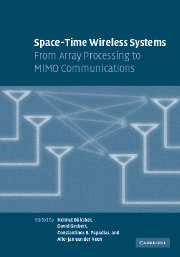Book contents
- Frontmatter
- Contents
- List of contributors
- Acknowledgments
- Introduction
- Part I Multiantenna basics
- Part II Space-time modulation and coding
- Part III Receiver algorithms and parameter estimation
- 12 Array signal processing
- 13 Optimal subspace techniques for DOA estimation
- 14 Blind and semiblind MIMO channel estimation
- 15 MIMO receive algorithms
- 16 Space-time turbo coding
- 17 Training for MIMO communications
- Part IV System-level issues of multiantenna systems
- Part V Implementations, measurements, prototypes, and standards
- Index
16 - Space-time turbo coding
Published online by Cambridge University Press: 25 February 2010
- Frontmatter
- Contents
- List of contributors
- Acknowledgments
- Introduction
- Part I Multiantenna basics
- Part II Space-time modulation and coding
- Part III Receiver algorithms and parameter estimation
- 12 Array signal processing
- 13 Optimal subspace techniques for DOA estimation
- 14 Blind and semiblind MIMO channel estimation
- 15 MIMO receive algorithms
- 16 Space-time turbo coding
- 17 Training for MIMO communications
- Part IV System-level issues of multiantenna systems
- Part V Implementations, measurements, prototypes, and standards
- Index
Summary
Introduction
In digital communication systems, error correcting coding is used to combat channel impairments such as noise or fading. The discovery of an iterative “turbo” decoding strategy (Berrou et al., 1993) started a new era in error correcting coding. Turbo codes were quickly adopted for wireless cellular standards like CDMA2000 and UMTS. Basic building blocks are soft in/soft out decoders connected through interleavers. With each decoding iteration, reliability information is exchanged, and a priori knowledge is updated by new, or extrinsic informationa mechanism similar to a turbo engine.
The advance of silicon technology facilitates the implementation of more sophisticated algorithms at the receiver, enabling iterative processing not only within the channel decoder, but also over the channel interface, such as the detector of a multiple input/multiple output (MIMO) antenna communication scheme. MIMO techniques (e.g., Winters et al. (1994)) allow to increase the data rate while keeping the bandwidth unchanged, thus making better use of the scarce spectral resources. They have recently found their way into a number of wireless communication standards, like IEEE 802.11n wireless LAN and 802.16 wireless MAN.
In this chapter, we apply turbo processing to the detection and decoding of signals transmitted over MIMO channels. We first outline several variants of coding over space and time, and determine the ultimate capacity limits of MIMO channels. We then study the properties of iterative processing structures, explain the exchange of reliability information and discuss the convergence behavior of iterative decoding in the MIMO context.
- Type
- Chapter
- Information
- Space-Time Wireless SystemsFrom Array Processing to MIMO Communications, pp. 322 - 341Publisher: Cambridge University PressPrint publication year: 2006
- 1
- Cited by



